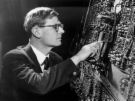-
(b.) -1919 August 02(d.)1997 December 22
Bio/Description
A pioneering British computer designer; along with David Caminer, he designed England's first business computer, the LEO computer, produced by J. Lyons and Co in 1951. He was educated at King Edward's School, Bath, and Clifton College, Bristol. He studied at Trinity College, Cambridge from 1937 to 1940, reading Natural Sciences, and graduating with first class honours. He joined the Air Ministry Research Establishment in Swanage, to work on radar, and went with it to Malvern where it was renamed the Telecommunications Research Establishment (where he met Maurice Wilkes). After the war he returned to Cavendish Laboratory at Cambridge to research ultrasonic waves in liquids and obtained a PhD.
He was recruited as chief engineer by the catering firm of J. Lyons (known in the high street for its tea and cakes and in the business world for its innovative approach to supply chain management). They had decided as early as 1947 that the future lay with computers, and since nothing suitable was available, they resolved to build one. He was introduced to them by Wilkes of Cambridge, who suggested that they construct a copy of the EDSAC machine. His approach was to leave the design unchanged as far as possible, while improving reliability by identifying the points of failure (notably electronic valves) and developing test procedures that enabled component failures to be anticipated and prevented. The machine went into operation in early 1951, and was used to its full capacity by 1954, at which point the company decided to build a second machine. They also saw the potential in building computers for use by other companies, and in 1955 set up a subsidiary, LEO Computers Ltd, with him as technical director. In this capacity he was responsible for the development of the successor machines LEO II and LEO III. By 1961 it was clear that the company did not have the resources to build its own computers indefinitely, so Lyons sold the operation to English Electric. He was appointed head of research in English Electric Computers, which went through a series of mergers eventually becoming part of ICL in 1968. He remained with the company until his retirement in 1984, in a variety of product strategy roles. Maurice Wilkes wrote, "it is a sad fact that, although he remained active in ICL at a senior level, he never found a role that in any way matched his track record or gave full scope for his abilities." He served for many years as president of ECMA, the European Computer Manufacturers' Association, helping to build it into an organization respected for the quality and timeliness of its work.
In retirement he was one of the original court members (from 1988) of the Worshipful Company of Information Technologists and "the mainspring of their Apprenticeship Scheme". He was also editor of a series of technical books. He edited the ICL Technical Journal between 1990 and 1996. His predecessor, Jack Howlett, commented: "John took the task of editing the journal with great seriousness, energy, and enthusiasm, and spared no effort in ensuring that the papers for each issue... met his exacting standards for content, presentation, and written English. He was very good indeed at discussing the content and form of a possible paper with a potential author, and, with an experienced author... helping to sort out the essential ideas and put them in the right logical order." He also frequently intervened with the managers of potential authors to allocate time and recognition for this activity. He also made contributions to documenting the history of computing, for example through the Science Museum's recorded interviews with UK pioneers.
-
Date of Birth:
1919 August 02 -
Date of Death:
1997 December 22 -
Gender:
Male -
Noted For:
Co-designer of England's first business computer, the LEO computer -
Category of Achievement:
-
More Info:


